The Samsung 850 EVO 4TB SSD Review
by Billy Tallis on July 11, 2016 10:00 AM ESTRandom Read Performance
The random read test requests 4kB blocks and tests queue depths ranging from 1 to 32. The queue depth is doubled every three minutes, for a total test duration of 18 minutes. The test spans the entire drive, which is filled before the test starts. The primary score we report is an average of performances at queue depths 1, 2 and 4, as client usage typically consists mostly of low queue depth operations.
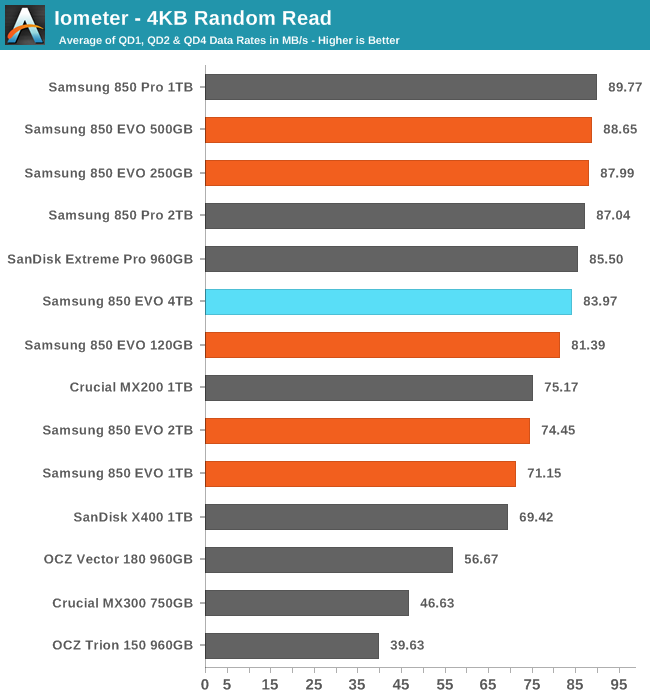
Random read performance of the 4TB 850 EVO is substantially better than the 1TB and 2TB 850 EVOs, but still not quite as fast as the best MLC drives or the 500GB and 250GB 850 EVOs.
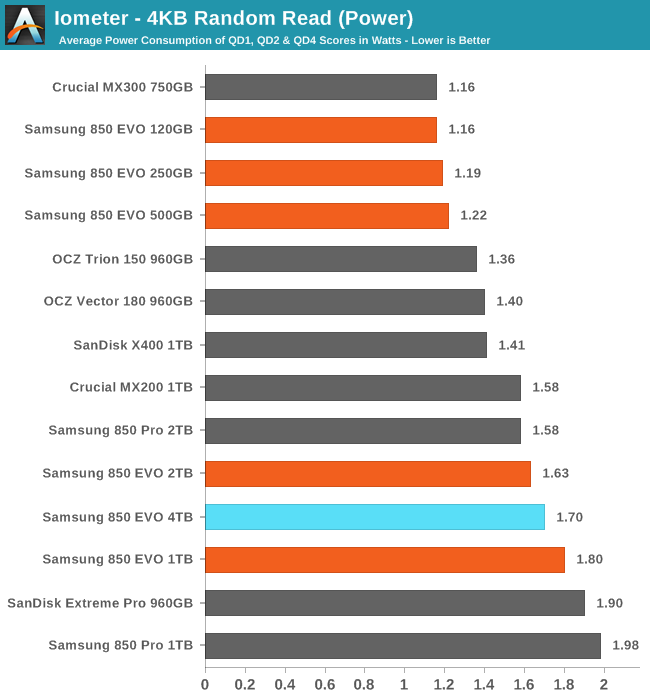
The power consumption of the 4TB 850 EVO is slightly higher than the 2TB model, but overall the efficiency is improved over the smaller drive with the same controller but older NAND.
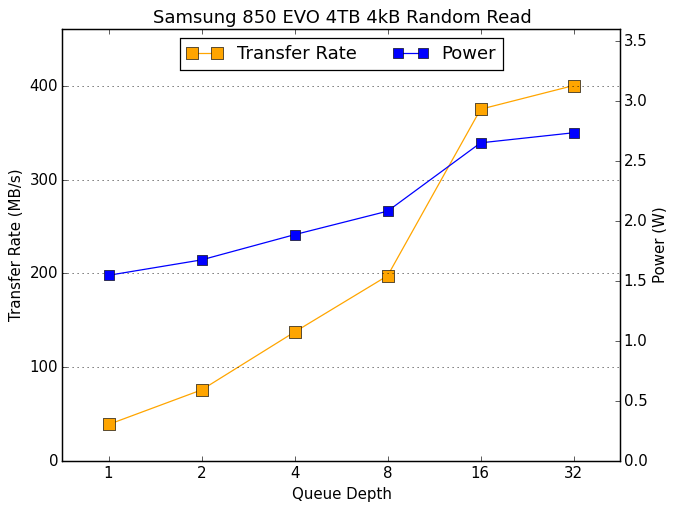 |
|||||||||
The scaling behavior of the 4TB 850 EVO is almost identical to the 2TB model, just with slightly higher performance and power consumption across the board.
Random Write Performance
The random write test writes 4kB blocks and tests queue depths ranging from 1 to 32. The queue depth is doubled every three minutes, for a total test duration of 18 minutes. The test is limited to a 16GB portion of the drive, and the drive is empty save for the 16GB test file. The primary score we report is an average of performances at queue depths 1, 2 and 4, as client usage typically consists mostly of low queue depth operations.
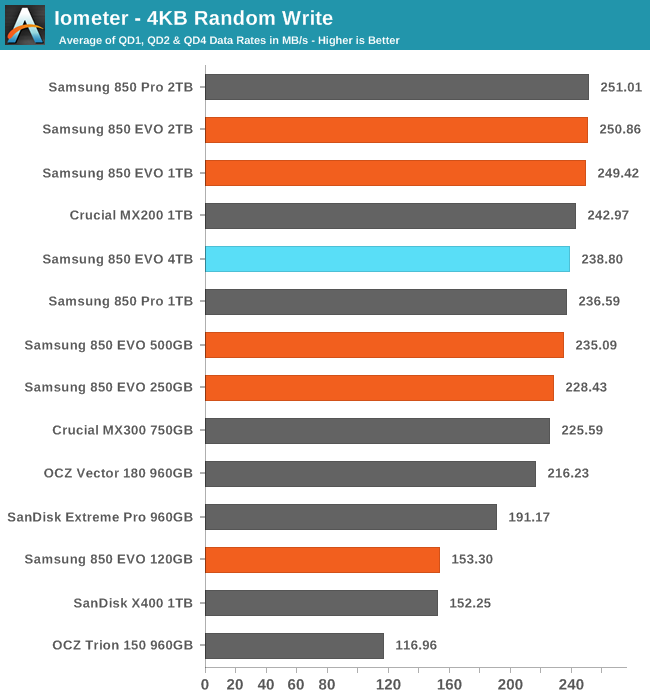
Random write speed for the 4TB 850 EVO is a little bit slower than for the 1TB and 2TB models, but still fast enough to beat almost all non-Samsung drives.
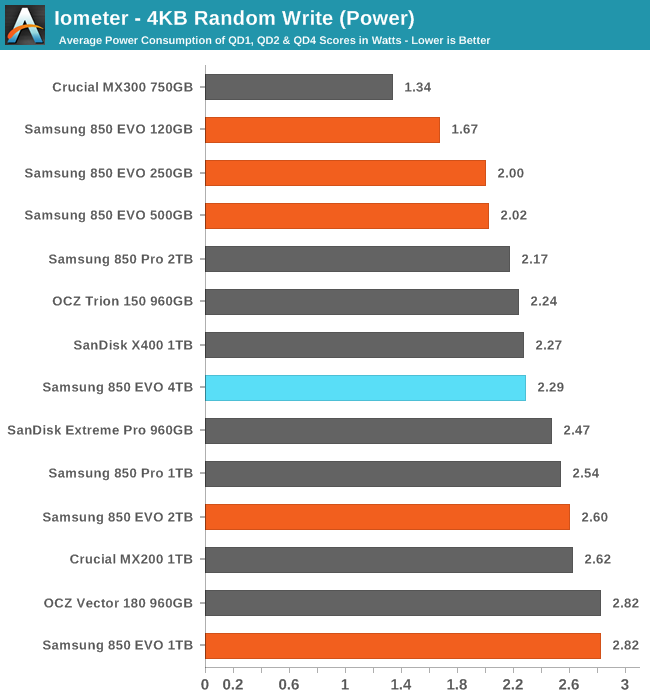
Power consumption of the 4TB 850 EVO is substantially better than the 1TB and 2TB counterparts, making it one of the most efficient large drives. The 750GB Crucial MX300 was still much more efficient.
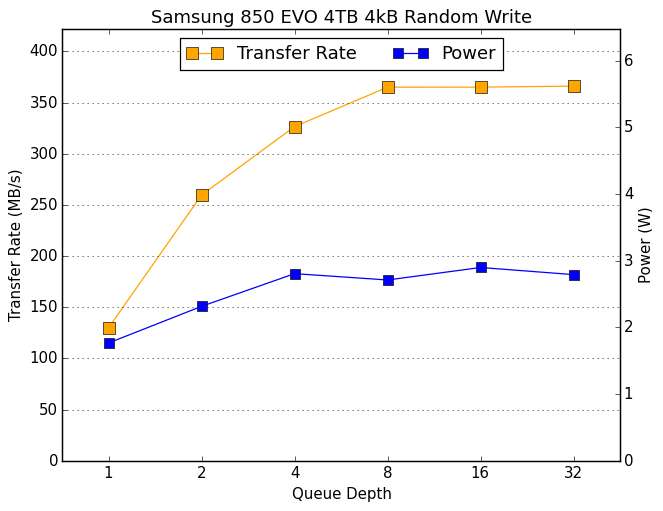 |
|||||||||
The lower performance score for the 4TB was apparently due to a regression in QD4 performance, where the 1TB and 2TB models were able to reach full speed but the 4TB needs a larger queue.










145 Comments
View All Comments
Eden-K121D - Monday, July 11, 2016 - link
Too Expensive. $999 would have been a sweet spot and a potential option for meZak - Monday, July 11, 2016 - link
The price will come down. Eventually.Ratman6161 - Monday, July 11, 2016 - link
Doesn't really mater if the price goes down, its still a niche product. The EVO's are great general purpose desktop drives. But the people who need a general purpose desktop drive, mostly don't need 4TB and would not buy one at $500 let alone at $1500. In my case, I've got a 250GB Evo and a 1 TB spinning disk for storage of music, pictures, video etc. So I guess a cheap enough 2 TB SSD could work for me just because it would be marginally easier to not have two separate chunks of storage to deal with...but thats just a marginal increase in convienience. The stuff I have on a spinning disk doesn't really need the performance of an SSD anyway.I know, now someone will jump in with "well I sure need that 4 TB" but I still say that isn't the norm. I really don't believe they will sell very many of these compared to the 1 TB and below even if the price comes down.
Meteor2 - Monday, July 11, 2016 - link
I don't need it. But it's exciting to see this progress in SSDs. It'll take a while but mass production will bring the price/size ratio down.Impulses - Monday, July 11, 2016 - link
OTOH lack of competition will probably counter that to an extent... But I'm glad it exists too, if nothing else it might mean more sales on the 2TB. :pleexgx - Sunday, August 7, 2016 - link
was so funny when i clicked on 25% OP, but really the extra OP is really only needed for places where your writing constantly as normally the drive is Trimmed (most SSD/HDDs life is read then write, unless in a server setup that does lots of writes) the drives normal hidden OP is what 400-500MB ?beginner99 - Tuesday, July 12, 2016 - link
Agree. This shows that HDDs are here to stay for another decade. The same for 4 TB in form of a HDD can be had for about $130. So that 1/10th of the SSD price and as you said for media files, you don't need an SSD at all.Impulses - Wednesday, July 13, 2016 - link
Another decade? That seems like a stretch unless you're hoarding BD tips and the like... A decade ago we didn't even have SSDs.joex4444 - Tuesday, July 19, 2016 - link
If you have 4TB of stuff to store and it's mostly media that is accessed infrequently, it would only make sense to buy a 4TB SSD over a 4TB HDD if the prices are comparable. We've technically had SSDs for decades, it's just that they used to be in the millions of dollars per drive rather than $100 or so. Exactly how production will change to make 4TB drives cheaper isn't clear. It could be that we've already reached the lowest price per GB and all that remains is to have that scale linearly. This would mean that if 250GB drives cost $60, then a 4TB drive should cost 16 times that, or $960. Maybe some kind of discount could bring it into the $750 range, but in order to get down to $130 we need significant changes. That would put a 250GB drive on the order of $25.JimmiG - Wednesday, July 13, 2016 - link
Of course it's not "needed" right now, but it's nice to see progress. The 6 GB HDD I used in my Pentium system was plenty at the time - I didn't "need" those fancy new 20 GB drives...